Haryana State Board HBSE 7th Class Science Solutions Chapter 4 Heat Textbook Exercise Questions and Answers.
Haryana Board 7th Class Science Solutions Chapter 4 Heat
HBSE 7th Class Science Heat Textbook Questions and Answers
Question 1.
State similarities and differences between the laboratory thermometer and the clinical thermometer.
Answer:
Laboratory Thermometer: While performing experiments involving measurement of temperature in the laboratory, a mercury thermometer is used. It is a thermometer having graduations marked on Celsius scale from 0°C to 100°C.
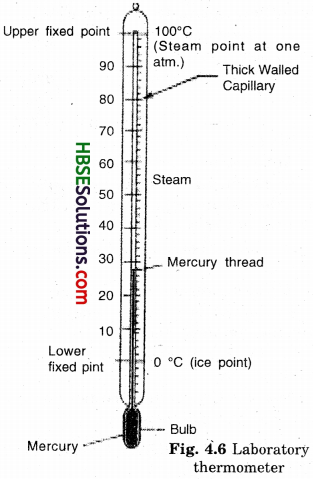
The difference between the lower and upper fixed points is called range of the thermometer. The range of a mercury thermometer is 100°C. A mercury thermometer having graduations from 0°C to 100°C is shown in figure 4.8.
Clinical Thermometer:
To measure the temperature of a person running fever, doctor uses a thermometer known as Clinicdl Thermometer. It is a specially designed mercury thermometer and is used in the clinics and hospitals by doctors to measure human body temperature.

In construction, it differs from laboratory thermometers, in the sense that a kink or constriction is provided in the stem just above the bulb. Because of this kink, mercury doesn’t fall back into the bulb when clinical thermometer is taken out of the mouth of a patient to know the temperature. A jerk is given to the thermometer so that it is set again for measuring human body temperature. The temperature interval marked on the clinical thermometers ranges from 35°C to 43°C.
![]()
Question 2.
Give two examples each of conductors and insulators of heat.
Answer:
Conductors: aluminium, iron
Insulators: plastic, wood
Question 3.
Fill in the blanks:
(a) The hotness of an object is, is determined by its …………… .
(b) Temperature of boiling water cannot be measured by a …………… thermometer.
(c) Temperature is measured in degree ……………. .
(d) No medium is required for transfer of heat by the process of ………….. .
(e) A cold steel spoon is dipped in a cup of hot milk. It transfers heat to its other end by the process of …………. .
(f) Clothes of …………… colours absorb heat better than clothes of light colours.
Answer:
(a) Touching
(b) Clinical
(c) Celsius
(d) Radiation
(e) Conduction
(f) Dark
Question 4.
Match the following:
| (i) Land breeze blows during | (a) summer |
| (ii) Sea breeze blows during | (b) winter |
| (iii) Dark coloured clothes are preferred during | (c) day |
| (iv) Light coloured clothes are preferred during | (d) night |
Answer:
| (i) Land breeze blows during | (d) night |
| (ii) Sea breeze blows during | (c) day |
| (iii) Dark coloured clothes are preferred during | (b) winter |
| (iv) Light coloured clothes are preferred during | (a) summer |
Question 5.
Discuss why wearing more layers of clothing of during winter keeps us warmer tljian wearing just one thick piece of clothing?
Answer:
More layers of clothing keep us warm in winters as they have a lot of space between them. This space gets filled up with air. As air is a bad conductor, it does not allow the body heat to escape out.
Question 6.
Look at Fig. 4.10. Mark where the heat is being transferred by conduction, by convection and by radiation.
Answer:
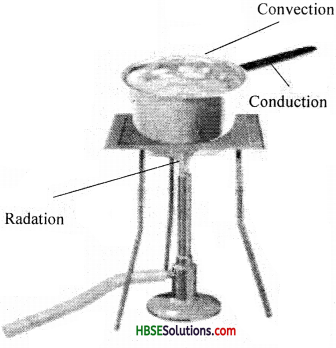
Question 7.
In places of hot climate it is advised that the outer walls of houses be painted white. Explain.
Answer:
In places of hot climate it is advised that the outer wail of houses be painted white because white colour do not radiate heat easily.
Question 8.
One litre of water at 30°C is mixed with one litre of water at 50°C. The temperature of the mixture will he:
(a) 80°C
(b) More than 50°C but less than 80°C
(d) 20°C
(d) Between 30°C and 50°C
Answer:
(b) More than 50°C but less than 80°C
![]()
Question 9.
An iron ball at 40°C is dropped in a mug containing water at 40°C. The heat will:
(a) Flows from iron ball to water.
(b) Not flow from iron ball to water or from water to iron ball.
(c) Flows from water to iron ball.
(d) Increase the temperature of both.
Answer:
(a) flows from iron ball to water.
Question 10.
A wooden spoon is dipped in a cup of ice-cream. Its other end:
(a) Becomes cold by the process of conduction.
(b) Becomes cold by the process of convection.
(c) Becomes cold by the process of radiation.
(d) Does not become cold.
Answer:
(d) does not become cold.
Question 11.
Stainless steel pans are usually provided with copper bottoms. The reason for this could be that:
(a) Copper bottom makes the pan more durable.
(b) Such pans appear colourful.
(c) Copper is a better conductor of heat than the stainless steel.
(d) Copper is easier to clean than the stainless steel.
Answer:
(c) Copper is a better conductor of heat than the stainless steel.
Extended Learning – Activities And Projects
Question 1.
Go to a doctor or your nearest health centre. Observe the doctor taking temperature of patients. Enquire:
(a) Why he/she dips the thermometer in a liquid before use.
(b) Why the thermometer is kept under the tongue.
(c) Whether the body temperature can be measured by keeping the thermometer at some place other than mouth.
(d) Whether the temperature of different parts of the body is the same or different. You can add m.ore questions which come to your mind.
Answer:
Do yourself. You can take help of your family doctor.
Question 2.
Go to a veterinary doctor (a doctor who treats animals). Discuss and find out the normal temperature of domestic animals and birds.
Answer:
Do yourself.
Question 3.
Wrap a thin paper strip tightly around an iron rod. Try to burn the paper with candle while rotating the iron rod continuously. Does it burn? Explain your observation.
Answer:
Do yourself.
![]()
Question 4.
Take two similar transparent glass bottles having wide mouths. Put a few crystals of potassium permaganate or pour a few drops of ink in one bottle. Fill this bottle with hot water. Fill the other bottle with cold water. Cover the cold water bottle with a thick piece of paper such as a postcard. Press the postard firmly with one hand and hold the bottle with the other hand. Invert the bottle and place it on top of the hot water bottle. Hold both the bottles firmly. Ask some other person to pull the postcard. Observe what happens. Explain.
Answer:
Do yourself.
HBSE 7th Class Science Heat Important Questions and Answers
Very Short Answer Type Questions
Question 1.
What is heat?
Answer:
The energy transferred from one body to another body due to a temperature difference between them is called heat.
Question 2.
Define temperature.
Answer:
Temperature is the degree of hotness or coldness of a body.
Question 3.
Define thermometer.
Answer:
A device used for measuring the temperature of different objects is called a thermometer.
Question 4.
Hot water bottles are used for fermentations. Explain why?
Answer:
Hot water bottles are used for fermentation as the water does not cool quickly due to its large specific heat capacity.
Question 5.
When equal amount of air, iron and oil are heated from 15°C to 25°C. List them in the order of increasing expansion.
Answer:
Iron, oil, air.
Question 6.
Name any four substances which expand on heating.
Answer:
Aluminium, steel, iron and copper.
Question 7.
Name any two substances which have negligible changes in length on heating.
Answer:
Pyrex glass, Invar.
Question 8.
Name two substances which contract on heating?
Answer:
Ice, Bismuth.
![]()
Question 9.
Do all liquids expand when heated or is there any exception?
Answer:
Yes, below 4°C when heated, water contract in stead of expanding.
Question 10.
Which substances has the highest heat capacity?
Answer:
Water.
Question 11.
What is the temperature of a normal human being on the Celsius scale?
Answer:
The temperature of a normal human being on the Celsius scale is 37°C.
Question 12.
Name the thermometer used for measuring the temperature of the human body.
Answer:
The thermometer used to measure the temperature of a human body is called clinical thermometer.
Question 13.
Define convection.
Answer:
The phenomenon due to which particles of a medium actually move to the source of heat energy and then move away from it after absorbing heat energy is called convection.
Question 14.
Why is convection not possible in solids?
Answer:
The molecules of a solid are held strongly due to intermolecular forces. As these molecules cannot travel to the source of heat energy, convection is not possible in case of solids.
Question 15.
What is ventilation?
Answer:
The process by which impure and warm air inside a room is continuously replaced by fresh air from outside is called ventilation.
Question 16.
What do you understand from the term lower standard point?
Answer:
The 0°C correspondence to the temperature of pure melting ice and is called the lower standard point.
Question 17.
What do you understand by upper standard point?
Answer:
100°C corresponds to the temperature of pure boiling water and is called the upper standard point.
Question 18.
Define conduction.
Answer:
The process of transmission of heat energy in solids without the actual movement of particles from their position is called conduction.
![]()
Question 19.
Give two examples to show that heat caused biological changes.
Answer:
(i) Conversion of ‘gur’ into alcohol.
(ii) Conversion of milk into curd.
Question 20.
Why is ice wrapped in gunny bags?
Answer:
Gunny bags have a number of fine pores, filled with air. Air being a bad conductor of heat does not allow the external heat to go in and melts the ice.
Question 21.
Why is tea generally served in China clay cups and plates?
Answer:
Because the China clay is bad conductor of heat and checks the heat conduction from the tea to the surroundings and thus keeps the tea hot.
Question 22.
By which of the processes (conduction, convection, radiation), it is not possible to transfer heat?
(i) In a vacuum
(ii) Through the solid material.
Answer:
(i) Conduction and convection
(ii) Convection and radiations.
Question 23.
Why do we use cooking utensils made of metals and alloys?
Answer:
Metals and alloys are good conductors of heat so that the heat from the flame is conducted to the food inside quickly and efficiently.
Question 24.
Is medium necessary for the transference of heat by radiations?
Answer:
No, medium is not necessary for the transference of heat by radiation.
Question 25.
Why do we feel warm while standing beside a burning furnace?
Answer:
When we stand beside a burning furnace, we feel warms, because of the heat radiation coming from the furnace.
Question 26.
Firemen wear helmets made from brass polished from outside. Why?
Answer:
Brass polished helmets reflects most of the heat and absorbs only a very little part of it when they fight against a fire.
![]()
Question 27.
When does the conduction of heat stop in two bodies in contact?
Answer:
The conduction of heat stops in two bodies in contact when both attain the same (equal) temperature. In this position they have no temperature difference.
Question 28.
Why is the handle of a press made of ebonite or wood?
Answer:
The handle of press is made of ebonite or wood, because ebonite and wood are bad conductors of heat. So the heat does not reach in our body.
Question 29.
Define radiation.
Answer:
The transfer of heat energy from a hot body to a cold body directly, without heating the space in between the two bodies is called radiation.
Question 30.
Define insulators.
Answer:
The materials which do not allow heat to pass through them easily are poor conductors of heat such as plastic and wood. Poor conductors are known as insulators.
Question 31.
What is thermos flask?
Answer:
Thermos flask is a device in which heat losses due to conduction, convention and radiation are minimised.
![]()
Short Answer Type Questions
Question 1.
The cooking utensils are made of metals like aluminium or copper while their handles are made of wood. Why?
Answer:
The cooking utensils are made of metals like aluminium or copper because these metals are good conductors of heat so they help in the transfer of heat.
The handles of cooking utensils are made up of bad conductors such as wood, plastic etc. As the handles made of bad conductors do not get heated up while cooking, we can hold them easily.
Question 2.
Kites and eagles fly without flapping their wings. Why?
Answer:
During the day, hot air surrounding the land gradually rises up and a convection air current develops. Kites and eagles move along this rising current without flapping the wings to fly high up in the sky.
Question 3.
Why do the birds puff up their feathers in winter?
Answer:
The birds puff up their feathers in winter, because in doing so they trap large amount of air, which in turn acts as an insulator and does not allow their body heat to flow out.
Question 4.
Explain briefly the formation of air currents.
Answer:
In coastal areas, during the day, the cool air blows from sea towmrds the land called sea breeze. During the night, the cool air blows from land to sea called the land breeze. This happens because of convection air currents. At night, land cools down much faster than sea. So, sea is warmer than land and the air current blows from land to sea. During the day, land is hotter than sea. As a result, the air rises up and cold air from sea blows towards the land to take its place.
Question 5.
Cement or concrete floors are made in pieces with metals or glass strips in between. Give reasons.
Answer:
It is done to allow for the expansion in summer and contraction in winter. If cement or concrete floors are made out in one continuous pieces. It would develop crackes due to contraction and expansion.
Question 6.
Room heaters have shiny reflectors. Why?
Answer:
Room heaters have shiny reflectors as the shiny surface absorbs very little heat. They reflect all the heat which makes the room heaters more effective.
![]()
Question 7.
Why is the handle of a pressure cooker covered with thick plastic?
Answer:
The handle of a pressure cooker covered with thick plastic, because plastic is a bad conductor of heat. Hence, the heat from the hot cooker does not flow to the handle, with the result that we can hold easily.
Question 8.
The desert sand is very hot in the day and very cool at night. Why?
Answer:
The desert sand has low specific heat capacity. So sand gets very hot in day time. During the night sand cools more quickly due to cold air which moves towards the sea.
Question 9.
Why is the handle of a metallic kettle covered with strips of cane?
Answer:
Cane strips is bad conductor of heat. Therefore, it cannot get heated when water is boiled in kettle. Therefore, the handle of a metallic kettle is covered with cane strips.
Question 10.
Why does the handle of an iron made of ebonite or wood?
Answer:
Ebonite or wood is a bad conductor of heat. Therefore, the heat from the iron is not conducted to the hand.
Question 11.
How does a blanket keep you warm in a cold night, even though it is not a source of heat?
Answer:
The blanket is made of wool, which is a bad conductor of heat. It has fine pores in which air is trapped which is also a bad conductor of heat. They do not allow heat to escape from our body to the surroundings. Therefore, the blanket keeps our body warm in winter.
Question 12.
Why are cloudy nights warmer than the clear nights?
Answer:
Cloudy nights are warmer than clear nights due to the fact that the heat which is radiated by the earth is again reflected back by the clouds. While on the other hand this phenomenon is not possible when the night is clear.
Question 13.
How are had conductors of heat useful in our daily life?
Answer:
Bad conductors are used for holding hot utensils in the kitchen. Bricks and mud which are bad conductors are used in building houses, especially in the ruler. regions. They keep houses warm in winter and cool in summer. The feathres of birds, hair and fur of animals keep them warm in winter, as they are bad conductor of heat.
Question 14.
Why do we wear woolen clothes in winter?
Answer:
Woolen clothes have fine pores filled with air. Wool and air are bad conductors of heat They do not allow heat of our bodies to escape out. Therefore woolen cloth keep the body warm in winter. And for the same reason we wear woolen cloth in winter.
![]()
Long Answer Type Questions
Question 1.
Describe briefly the process of conduction.
Answer:
Heat travels through solids by conduction only. The process of transmission of heat energy in solids without the actual movement of particles from their position is called conduction. Conduction takes place under the following conditions:
(i) A material medium that is compact.
(ii) No movement of any particle in the medium.
Thus, solids transmit heat though conduction. When a solid substance is heated, the particles that become hot start vibrating and pass on the excess energy to the neighbouring particles. This process continues till the whole body is heated. However during such an energy transfer, a particle does not change its position. Hence, heat is carried without the bodily movement of the particles.
There are some solids which allow the heat to pass through them. Such substances are called the conductors. Almost all metals such as iron, copper, silver, aluminium etc. are good conductors. The substances which do not allow the heat to pass through them are called the insulators. Wood, plastic, wool, clay etc. are bad conductors.
Question 2.
Write an experiment to prove that heat radiations can travel through vacuum.
Answer:
Take a flat bottomed flask. In the mouth of the flask fix a rubber stopper having two holes. Pass a thermometer through one hole and a glass tube with stopper through the other hole.
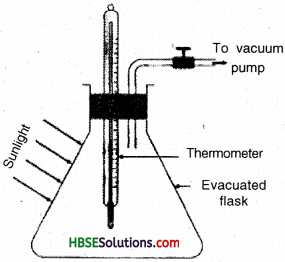
Remove air from the flask, by connecting to a vacuum pump. Record the temperature from the thermometer. Place the flask in bright sunlight or in front of an electric heater. It is observed that the thermometer records a rise in temperature. Thus, the experiment proves that transference of heat by radiaton requires no medium.
Question 3.
Explain the working of a thermos flask.
Answer:
Thermos flask is a special kind of flask for keeping liquids. It prevents loss or gain of heat by any of the three methods. It keeps liquid warm or cold for a long time. It was invented by Sir James Dewan in 1893.
It consists of a double-walled glass-cylinder. A vacuum is created in the space between the double walls. The two inner surfaces of glass walls are silvered. The flask is placed on a spring within a non-conduction cylindrical case to protect it from jerks and breakages. The gaps between flask and outer casing is packed with felt pads. The mouth of the flask is finally closed with a cork.

Since the container is made of glass which is a bad conductor of heat and therefore, the loss or gain of heat due to conduction is prevented. As there is vacuum between the double walls, it prevents transmission of heat by convection. Due to silvering of the inner surfaces, the heat loss by radiation is prevented. The cork and the felt pads also help to preserve the heat inside the flask. So, the hot liquids like tea, coffee, etc. remain hot and cold liquids like water, juice, etc. remain cold for a long time.
![]()
Question 4.
Write five applications of radiation.
Answer:
Applications of radiation:
(i) The base of cooking utensils is painted black so that it can absorb more heat and hence cooking is done fast.
(ii) Dark clothes are worn in winters as they absorb more heat from the sunlight and keep our body warm.
(iii) White clothes are worn in summer as they absorb very little heat and keep us cool.
(iv) Room-heaters have shiny reflectors as the shiny surface absorbs very little heat. They reflect all the heat which makes the room- heaters more effective.
(v) Crockeries are polished and painted white from outside so that they do not radiate heat easily.
Question 5.
Describe the process of radiation. How is it different from conduction and convection?
Answer:
Radiation is a process of transmission of heat in which heat energy travels in straight lines from hotter to cooler regions without the help of any intervening medium. It means that this process is different from the other two as it does not need any medium like conduction or convection. Radiation can take place in a vaccum. For example, heat from the sun reaches us through the outer space (vacuum) by means of radiation in the form of electromagnetic waves.
Differefnbe between radiation, conduction and convection:
| Radiation | Conduction and convection |
| 1. No medium is needed. | 1. A medium is needed. |
| 2. Heat energy is transferred in the form of electromagnetic waves. | 2. In conduction, heat energy is transferred from particle to particle but in convection heat energy is transferred by the transfer of metres. |
| 3. It is a fast mode of heat transfer. | 3. It is a slow mode of heat transfer. |
| 4. Medium (if any) is no heated. | 4. Medium is heated. |
![]()
Heat Class 7 HBSE Notes
- Our sense of touch is not always a reliable guide to the degree of hotness of an object.
- Heat: Heat is a form of energy which produces in us sensation of warmth. It causes hotness or coldness sensation in our body.
- Temperature: Temperature tells how hot a body is? Temperature of a body is the degree of hotness or coldness of the body.
- Heat flows in the direction of fall of temperature. Heat can be converted to other forms of energy like sound, light, mechanical energy etc. Other forms of energy can also be converted to heat energy.
- Effects of heat:
(i) The object becomes hot.
(ii) The object may expand in size.
(iii) The object may change in state.
(iv) Heat can speed up chemical reaction. - Temperature is measured by a device called thermometer.
- The thermometer that measure our body temperature is called a clinical thermometer. The range of this thermometer is from 35°C to 42°C. For other purposes, we use the laboratory thermometers. The range of these thermometers is usually from 10°C to 110°c.
- The laboratory thermometer used in laboratories. It is called Celsius thermometer. It has one hundred markings on it.
- The melting point of pure ice is called lower standard point. Its value is 0°C.
- The boiling point of pure water is called upper standard point. Its value is 100°C.
- Transfer of heat: Heat flows from one body to another body by temperature difference. The flow of heat is from higher temperature to lower temperature. There are three different ways of heat transfer: conduction, convention and radiations.
- Conduction of heat: The process in which heat is handed over from one particle to another in the direction of fall of temperature without the actual movement of the particles of the medium is called conduction.

- Good conductor of heat: The materials which allow heat to pass through them easily, are called good conductor of heat. For example, silver, copper, aluminium, mercury etc. are good conductors of heat.
- Bad conductor of heat: The materials which do not easily allow heat to pass through them are called bad conductors of heat or insulators. Wood, plastics, mud, cork, cotton, ebonite, asbestos, most gases and liquids are bed conductor of heat.
- Convention of heat: Convention is a process by which heat is transferred from one part of a substance to another part through the actual movement of its constituents particles (atoms or molecules). Only liquids and gases convert heat. A solid cannot do so because solids do not flow like liquids or gases do.
- Radiation of heat: The process by which heat travels from one body to another without the intervention of any material medium is known as radiation.
All hot objects transfer heat by radiation. Radiation does not require either a conducting medium or a convecting fluid. The sun transfers heat in all directions through the process of radiation. The radiations absorbed or emitted by a body depends upon the colour of the body.
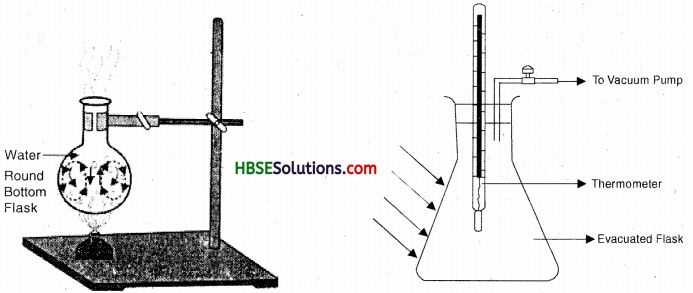
- Thermos Flask (Vacuum Flask): Thermos flask is used to keep things warm and cold. It consists of a double walled glass flask, having vacuum between the walls, kept inside metallic case with the cork supporters.
The outer and inner surfaces of the glass flask are highly silvered. The mouth of flask is fitted with air tight cork.
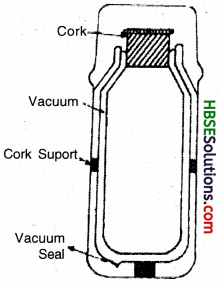
(i) The vacuum between the two walls of the flask prevent heat transfer by conduction or convection.
(ii) The silver coating of the walls of the vessels reflects back heat radiations. Thus heat by radiation can neither enter inside the flask nor go out of the flask.
(iii) The air-tight cork, which is bad conductor of heat prevents any loss of heat by conduction or convection.
Some heat may be transferred by conduction through thin glass walls at the neck and the poorly conducting cork. Total transfer of heat is very-very small, thus hot or cold liquid kept inside will keep its temperature for a long time.